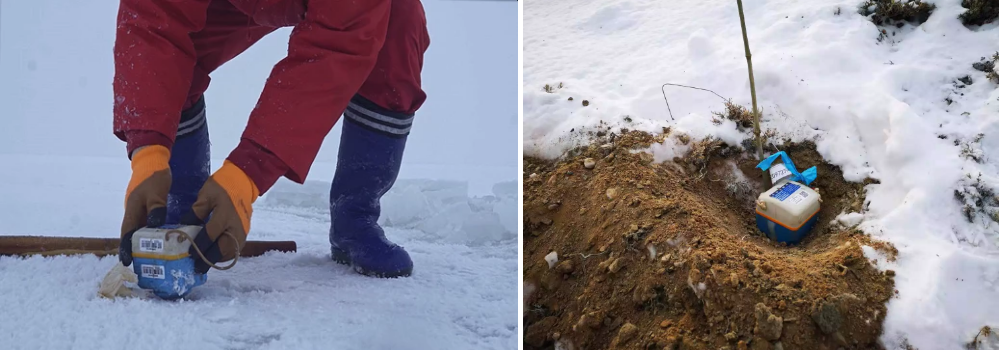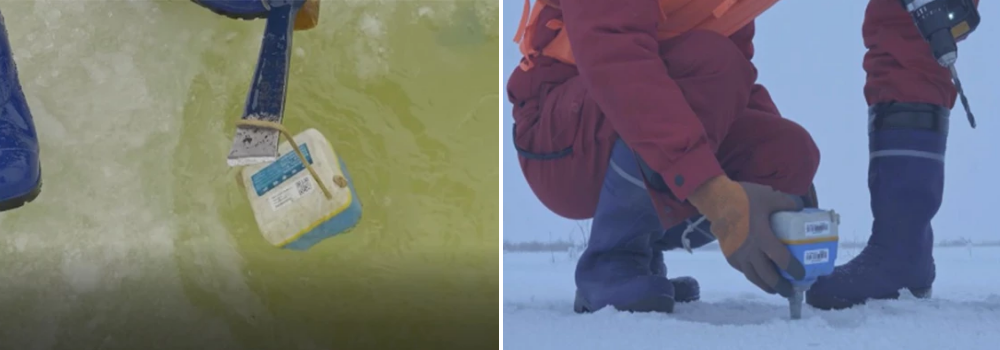


Equipped with 53,000 SmartSolo nodes, the Jimusar 3D seismic exploration project startup was in November 2019. With a production area covering 1,290 km2 and total 519,604 shots to acquire, recording operations were complete in just 75 days. Safe high-quality efficient production is where SmartSolo shines, with reliable performance in extreme temperature swings, and ease of use in complicated terrain. With SmartSolo, high density receiver geometry was straightforward, and using a combination of conventional Slip Sweep and DSSS source technology, an average daily production of 7,217 shots was achieved, with a maximum daily reaching 9,200 shots.

SmartSolo deployed on ice and snow-covered farmland
Jimusar is located at the North Eastern foot of the Tianshan Mountains in the Xinjiang Uygur Autonomous Region of China. It has a temperate continental climate with short hot summers and long severe winters. With production beginning in winter, the average temperature in the region was below -30°C (-22°F). The work area was variably made up of farmland, public forest, desert, grass land, and areas of reservoir, all presenting an assortment of sensor deployment challenges. In particular, areas close to the reservoirs where operations needed to be completed while frozen. Small deployment holes were made with electric drill, then with a rapid drop in temperature, the nodes were frozen even more securely in place, further ensuring sensor coupling.

Cultivated land, Reservoir, Swamp
SmartSolo in action
The SmartSolo node is small and light weight, improving deployment efficiency, and reducing HSE exposure. With no external connectors or cables, interference caused by leakage is avoided, and the smart sensor housing is strong and sealed. Depending on the terrain and conditions, some different deployment techniques were employed, but all remaining simple and effective. With quality control in mind, the nodes were checked and monitored, especially in the more densely populated areas, or where there was potential for changing conditions that might have some impact on the acquired data.

SmartSolo raised from a melted ice plunge… …redeployed to continue doing its job
Disassembly, charging, data download, and testing
The SmartSolo smart seismic sensor adopts a split design, where the main body and the battery pack can be disassembled and separated. This enables charging and data download to occur concurrently, but also enables (with additional batteries) the node to be assembled and returned to the field exceptionally quickly if desired. For this particular project ~4,500 stations were being downloaded and returned for deployment every day, with total daily data download taking around four hours to complete. After data download, each node was checked on the SmartSolo tester using production parameters. They were then assembled with battery ready for the next day's deployment. With this method and work flow of data download, charging, testing, and assembling for re-deployment, there is no hardware left redundant in the room, and equipment utilization rate is very high.

SmartSolo peripherals fully utilized
Generating deliverables
On larger scale acquisitions like this, to stay well organized, the allocated project space for data is established according to the survey line that has been picked-up that day. During the process of data download, quality control checks are completed to identify any station or production anomalies that may need further investigation. QC and self-test reports are generated, and the shot-list is checked for completeness. Smartsolo user then performs SEG data outputs according to the defined active spread template.
The Jimusar 3D seismic exploration project is the first where SmartSolo has been used in the Northern Xinjiang region of China. The project used EV56 high-precision vibe trucks for the seismic source, and SmartSolo IGU-16HR for the receiver spread. These two advanced technologies together worked very well to overcome acquisition challenges, resulting in well received production efficiency while preserving data quality.
